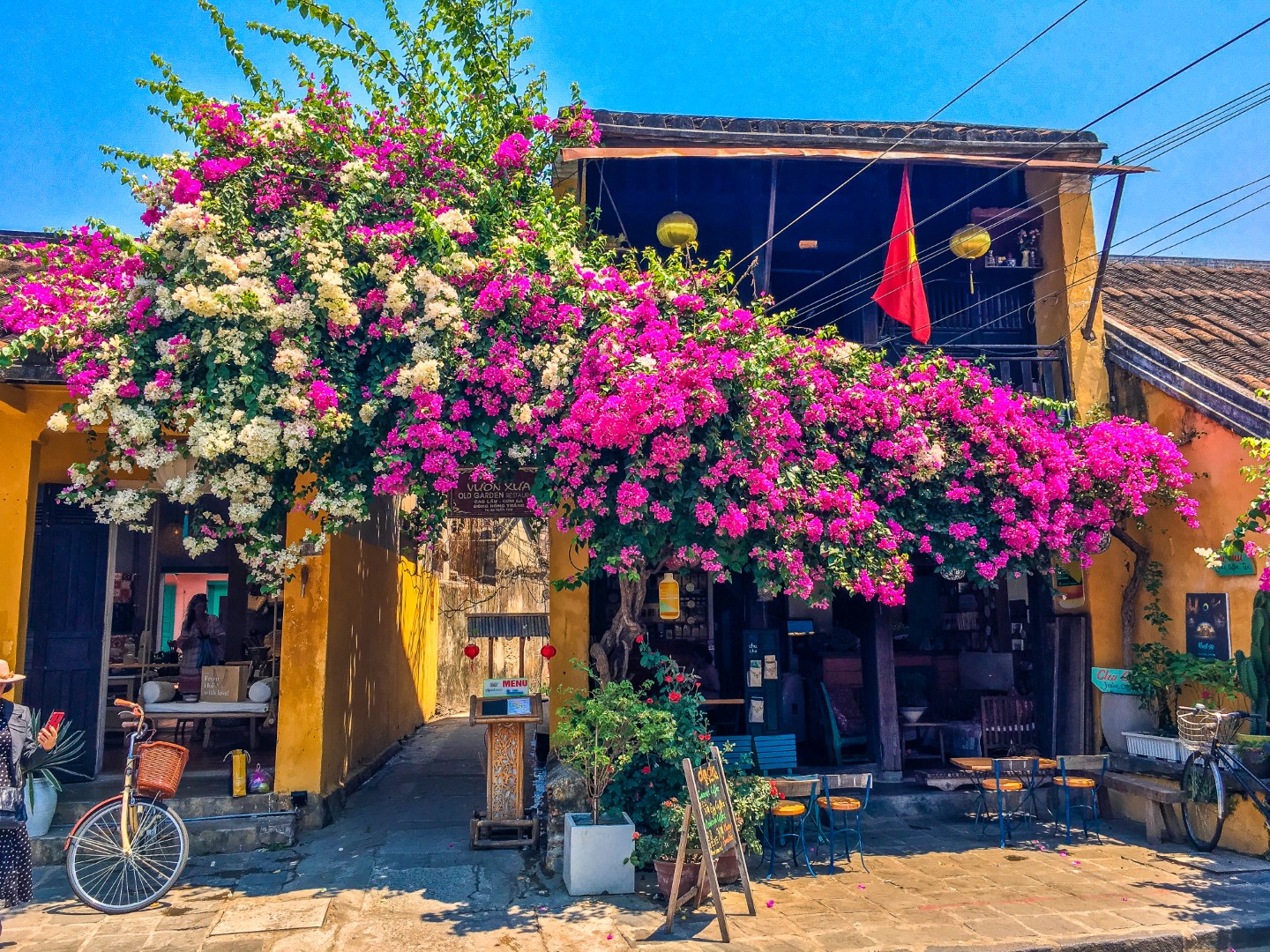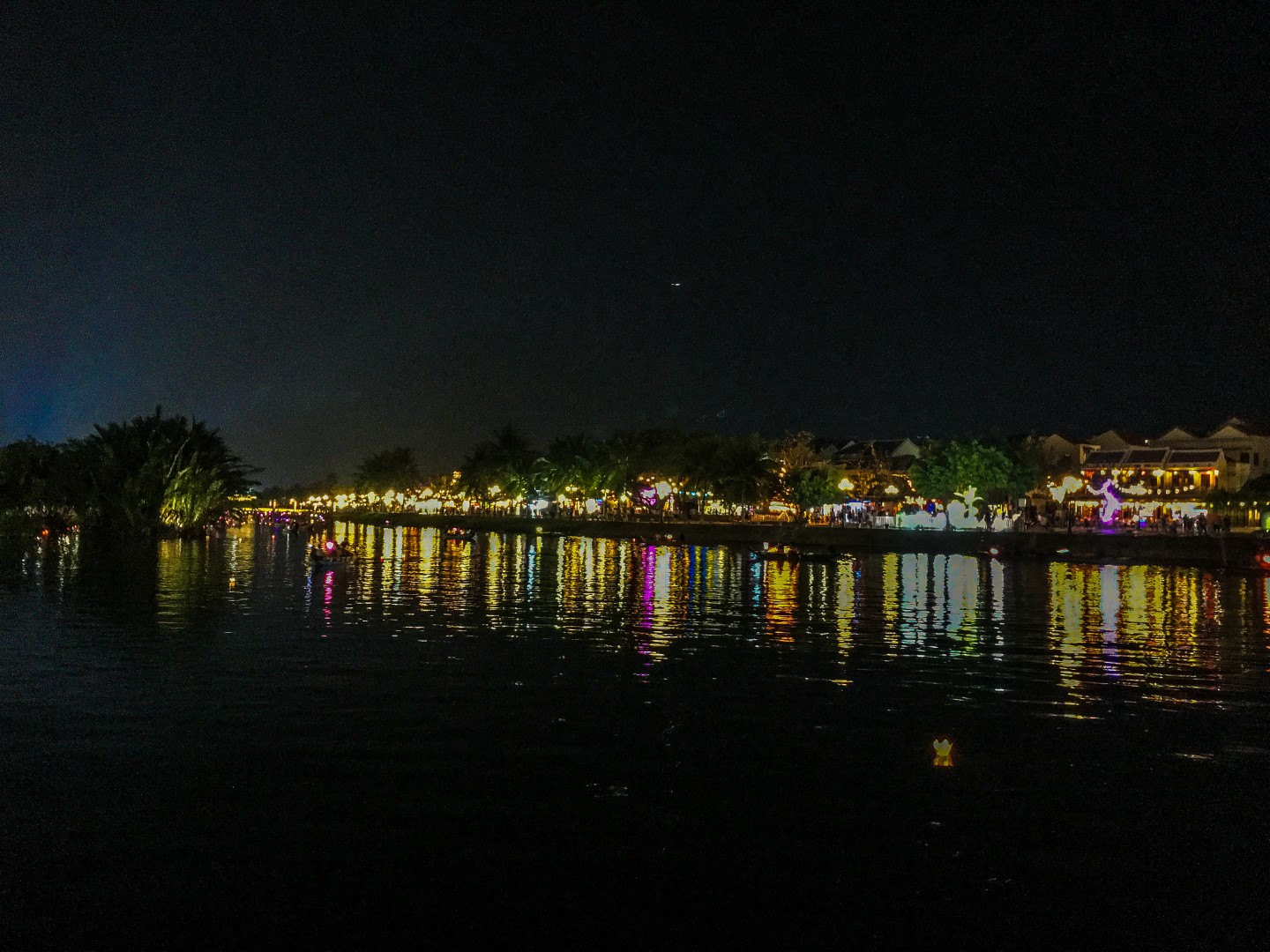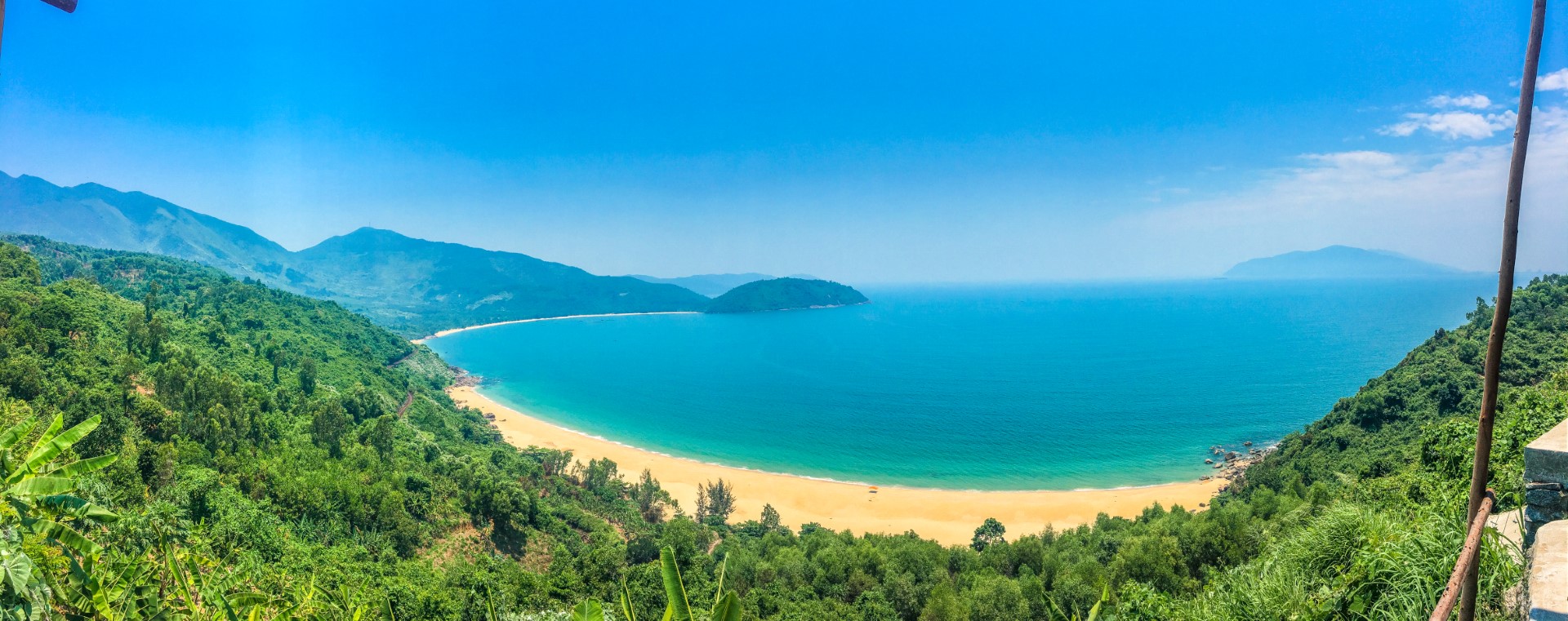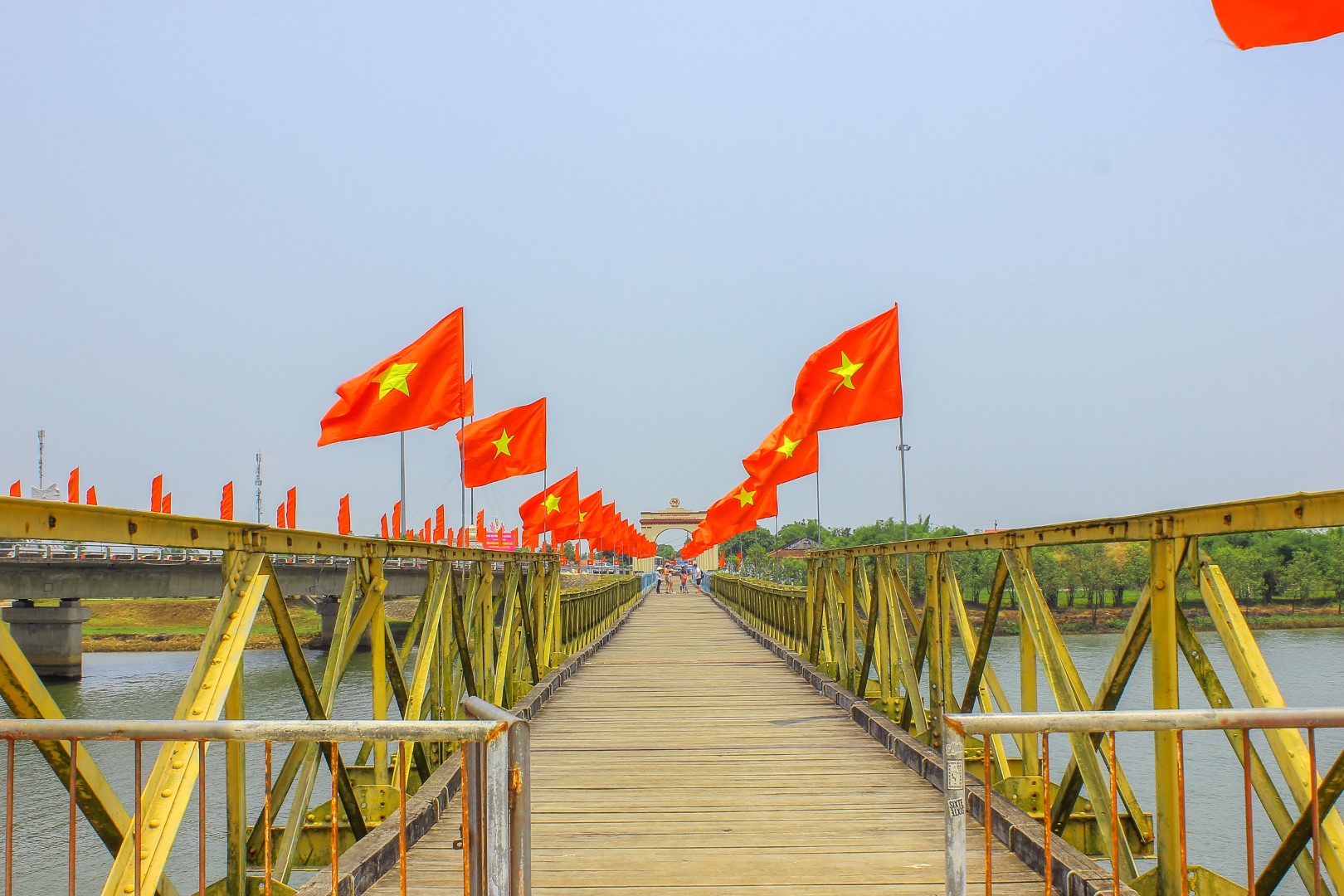Magical land of Hoi An. Canary yellow old town adorned by the floral fireworks of the bougainvillea. Tea shops by the hundred. Racetrack of the cyclo-rickshaw.
Up early to beat the heat and the crowds. Leave our fellow hotel guests to their sun loungers. We head for the ticket booth. You can walk the old town without a ticket, but the ticket is the gateway to the preserved old houses, museums and the covered Japanese bridge. Foreigners complain, but I think its a good deal. The funds keep the old town in good nick, and the whole tourist crowd keeps people employed. Tickets acquired from the ticket hut near Song Hoai Square.
It’s an incredible day. Brightest blue sky, faintest whisper of white clouds. The Ancient City’s bright yellow walls are intensified beneath this sunshine, contrasting spectacularly with the leafy trees. We stroll easily along the riverbank with the other early bird sightseers and Aunties hurrying to the market. Teenaged locals cycle past, some doubled up on their friend’s bike, chatting and sipping ice tea.

Turn left, to the Japanese Covered Bridge. Topped by a tiled roof and intricate decorative carvings, the bridge is bookended by red stucco gates which standout magnificently against the canary yellow of the surrounding buildings. Inside the bridge (on the bridge?), a man is checking tickets behind a small desk. He punches a hole in our tickets and waves us through. Locals cross the bridge freely, including Aunties carrying loads balanced across their shoulders. The ancient wood creaks and groans as the bridge takes the load. Built in the 18th century. It looks old. The wood is dark and stained, well loved. Above the door to the shrine is a carved sign, in striking red and gold. Some might think it’s just an old bridge, but what bridge have they ever crossed with an anteroom in it? Inside, the air is thick with incense smoke – jasmine. Locals light incense and leave offerings – fruit, lollies, even money sit undisturbed on a small bowl in front of a dark statue. One of our guides in Ho Chi Minh City told us that Vietnamese believe in everything – Buddhism, animism, ghosts. In here, I believe that.
Leave the beautiful creaky bridge behind, and walk into town. It’s so picturesque, I don’t think I’ll ever do it justice to describe it. Aunties open tea stalls beside the creek, locals and tourists cycle lazily through the streets. Footpaths become bicycle parking lots, but no one seems to mind.

Left turn, through the gates of the Cantonese Assembly Hall. The gates themselves are impressive, decorated in candy bright colours, mystical cloud swirls and golden dragons. Ticket punched by Auntie sitting at the gate. Beyond, the doorway through an imposing brick wall is framed by Chinese characters on shining black wood. Either side of the doorway are the ubiquitous marble lions standing guard. Fierce, stoic. Unmoving. Guardians of a doorway for who knows how many years. Inside the walls, the chatter of crowds dies away and we are left listening to the hushed whispers of other sightseers. It’s an incredible kaleidoscope of colours and patterns; flashy gold on imposing dark wood contrasts with rich scarlet and vibrant yellow, carved dragons curl protectively around posts, scales on their back in every shade of blue and green, yellow and brown patterned floor tile and hot pink desert roses in pots. A rainbow ocular assault. In the centre of the courtyard, a dragon rises from a pond to rest on billowing clouds. Coloured glass stones for eyes. I need my head on a swivel to take everything in properly as I walk.
Beyond the courtyard and dragon pond, the main temple. Another beautiful tiled roof topped by more dragons. The doorway is framed again, this time by an intricately carved lintel. Yet more dragons swirl up the red posts, and great curls of incense hang from the ceiling burning slowly. The air is heavy with the scent of sandalwood and jasmine. Numerous offerings have been left on the alter. The sound of a gong rings out softly. We continue down a corridor the left, and emerge in the garden behind the temple. Perfectly manicured, lush green and more potted bonsais than I can count. The back wall of the temple is covered in an immense mural in black and white. The mighty dragon makes another appearance, this time as a many headed version of deep blue with golden-yellow fins, rising from another pond in the centre of garden. It’s covered in mosaic – the chest scales look like upside down tea saucers.
Wandering through Hoi An is a sensory overload. Bright yellow buildings against clear blue skies, hot pink bougainvillea flowers hang in clouds off the side of shophouses. Music drifts out of cafes and shops, mixing with the chattering of the crowds trailing through the streets. An intoxicating blend of coffee and incense drifts on the breeze. I’m fully aware that I’m wandering around mouth agape.

Hoi An old town holds on to its history fiercely. A handful of ancient shophouses still exist, some even open for walk through tours. Houses of dark teak and smooth terracotta tiles, laid out in the old Hoi An shophouse style. Shop at the front, courtyard in the middle, work area out the back and the family’s residence upstairs. Internal courtyards open to the blue sky and filled with potted plants, heavy teak furniture resplendent with mother of pearl inlays. Walls groan under the weight of old black and white photographs. I inspect each inch of these incredible places, with the exception of the upstairs residence. In Duc An House, Uncle points out his relatives in photos on the wall and talks excitedly about his family member’s involvement in the Communist movement. The same family has lived in this property for over 400 years, apparently. The house has been razed and rebuilt many times, the current house was built in 1850 – according to my research later.
The old merchant house of Tan Ky perches in the same spot on the bank of the Thu Bon river as it has done for generations. Items ready for shipping were kept on the bottom floor, the family lives in the top floor. The old house is wedged between two other shophouses, one an old teahouse and the other converted to a trendy cafe and restaurant with tiny tables that face the river, shaded by a lush bougainvillea. The old house of Phung Hung seems palatial by comparison; not only is it wider than Tan Ky or Duc An house, we are allowed to venture to the second floor. The ground floor salon is filled with ancient looking teak furniture, occupied by Aunties and Uncles drinking tea and arguing, while the second floor looks down on them – like an atrium. The old floorboards creak under our weight, and there are souvenirs to buy on the second floor. The front veranda on the second level gives us an opportunity to see this little part of the old town from above. Tourists appear in waves, wandering through the streets. Young locals walk arm-in-arm down the road, stopping for tea and ice cream. I can still hear the oldies downstairs bickering. The same family has lived in the Phung Hung house for eight generations!

We leave the ancient houses and their almost as ancient families and head back east along Tran Phu. We turn right, into the Hoi An local market area. It’s flat out. The dreamy soft sounds of café music and bicycle bells is replaced by shouting, banging and scraping. The market is alive, heaving under the hot sun. Stalls are crammed into the main market building, but it spills out on the streets and by the river. Fruits, both fresh and dried, pile up on tables and in baskets. Buckets of fresh flowers, bright yellow and pink. Leafy green vegetables look set to wilt in the sun, before another umbrella or makeshift marquee appears to shade them. There’s tea of every imaginable sort, tourists trinkets, chopsticks by the hundred, herbs for curing everything and jars of homemade chilli sauce. I buy a few postcards to send home, and a couple to put in my scrapbook later.
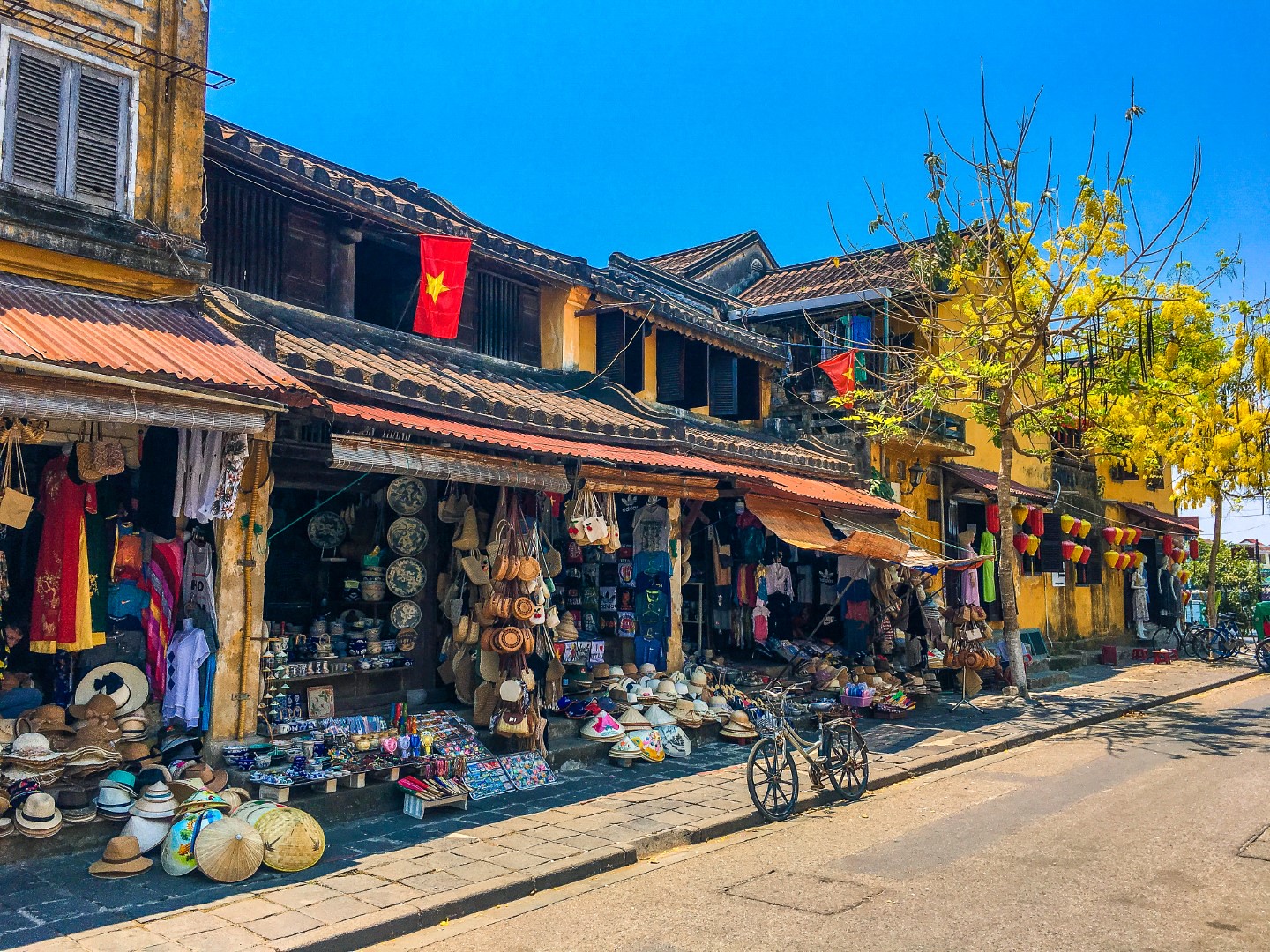
An entire street runs parallel to the market, specialising in tailors. Suits, dresses, shoes, skirts – order it all here. The tailor doesn’t have the fabric colour you want? Run across to the market, buy a few yards and run back! The tailors are busy – full of tourists ordering new wardrobes. Inside the market building, there’s a section devoted to food. Aunties wield woks over jet engine gas flames, or meat cleavers with frightening precision. Diners slurp on bowls of bun bo Hue, mi quang and the ubiquitous pho. You want banh mi? There’s stalls for that too – they’re packed. Grilled pork? Chicken intestines? The air is thick with the scent of herbs and spices – lemongrass, coriander, mint, chilli. Above the din of clanging woks, chatter rises to a dull roar. Watch out for the delivery of fresh chickens, wheeled at breakneck speed through the crowd on a trolley. It’s captivating, yet overwhelming and I find myself riding waves of noise back to the street.

Enjoying my Vietnam diaries? You can read the others here, or catch up on my Cambodian adventures!

